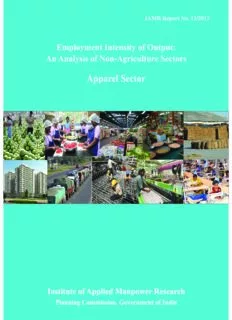
Apparel Sector PDF
Preview Apparel Sector
IAMR Report No. 12/2013 Employment Intensity of Output: An Analysis of Non-Agriculture Sectors Apparel Sector Employment Intensity of Output: An Analysis of Non-Agriculture Sectors Apparel Sector Indrakumar Institute of Applied Manpower Research Planning Commission, Government of India Acknowledgements First and foremost, the author sincerely acknowledges the Planning Commission, Government of India for sponsoring this research project. The project was initiated in consultation with the officials of Ministry of Textiles, Government of India. Special thanks go to Ministry of Textiles and its Subordinate Orgnaisations such as, Office of Textile Commissioner, Textile Committee, Handloom Commissioner etc. The author acknowledges the inputs given by the Industrial Federations and Associations. Confederation of Indian Industries (CII), Confederation of Indian Textile Industries (CITI), and Federation of Indian Chamber of Commerce and Industry (FICCI) were contacted at Delhi to get sector specific issues. In addition to these national level federations, Industrial associations at cluster level were also contacted from all over the country. Apparel Exporters & Manufacturers Association (AEMA) in Delhi, Bengal Hosiery Manufacturers Association (BHMA), in Kolkata, Cloth Manufacturers Association (CMAI) Chapters at Bengaluru, Kolkata and Mumbai, Gujarat Garment Manufacturers Association (GGMA) at Ahmadabad, Knitwear and Apparel Manufacturers Association at Ludhiana, South India Hosiery Manufacturers Association at Tirupur are associations contacted for this study. My sincere thanks are put on records towards these cluster level industrial associations for their valuable inputs. The base information about the wearing apparel clusters are contributed by the Apparel Export Promotion Council (AEPC) Gurgaon. The author would like to put on record his gratitude to the officials of AEPC for their valuable contribution. In addition to these, the author would like to acknowledge all the enterprises, establishments, and officials from all the clusters for their contribution in finalizing this report. The author would also like to thank Dr. A. Kamala Devi, Jt. Director for editing this report and Dr. Ruby Dhar to bring it into print form. Table of contents Section Title Page. No. Executive Summary I Study Design 1-4 Genesis 1 Objectives 1 Hypothesis 2 Methodology 2 Sampling frame 3 Chapter Plan 3 II Profile of the Sector 4-23 Structure of the sector 4 Performance of the sector 6 Employment 9 Market potential of the sector 13 Constraints 19 III Analysis – Reason for the change in employment 24-31 SWOT analysis 29 IV Suggestions and policy interventions 30 Case Study : Tirupur 33 References 35 Annexure 37 List of Tables Table No. Title Page. No. 1 Distribution of Apparel Units by Size 5 2 NIC 5 digit sub –sectors employment 2009-10 6 3 GVA share of the Apparel Sector 7 4 Share of Apparel Sector in Manufacturing 8 5 Employment trend in sectors 10 6 Employment share of the Apparel sector 11 7 Organised and Unorganised portion of employment 12 8 State wise employment in Apparel sector 13 9 Export of RMG and other textiles 16 10 Export trends of the sector 18 11 Product specification wise exports 2009-10 18 12 Financial year wise inflow of FDI in India 25 vi List of charts and graphs Chart No. Title Page. No. 1 Apparel Units by size 5 2 Share in overall manufacturing (ASI Data) 7 3 Growth rate of organised segment of the apparel sector 9 4 Employment share of the sector 10 5 Employment in apparel sector 11 6 Share of RMG in textile exports 16 7 US’s Import of Apparel: Comparative scenario 17 8 Per capita consumption of textiles 17 9 Export share of the sector 19 vii Executive Summary Apparel industry is one of the largest employment providing sectors in the country. The apparel is also the finest value added segment of the textile industry. Apparel sector is the single largest sector which is earning maximum foreign exchange for the nation. Totally 15 percent of the exports are from the apparel segment. The sector has provided total employment of 3.66 million in 1999-2000 which has increased to 8.92 million for the year 2004-05 with the compound annual growth rate of 19.5 percent between 1999-2000 and 2004-05. However, a negative growth (almost (-)4 percent) was registered for the period between 2004-05 and 2009-10. The employment has come down from 8.92 million in 2004-05 to 7.32 million in 2009-10 recording an absolute decrease of 1.60 million. Objective of the Study To explore the reasons for negative growth of employment in apparel sector during the reference period 2004-05 to 2009-10. Methodology and Sampling Technique Various stakeholders at different levels were approached with the proper surveyed tools and techniques. Cluster-wise approach was followed to gather the reasons. Findings Common factors which cause the slowdown in employment in the country are: • Slowdown/decline in export orders affected the working days of the units –workers were quietly given layoffs. It was mainly due to global crisis and slowdown in Europe and the US economy. • Atomization/modernization – machineries have replaced labourers: Not only labourers, even the managerial and administrative positions were also replaced with machineries. Introduction of new software for accounting (like tally) caused replacement of three accountants with one computer employee. • Price competitiveness of goods with the eighbouring countries like Bangladesh, China, and Pakistan: In these countries the cost of production is very less and inputs are available at cheaper prices as compared to India especially inputs such as cotton, yarn and labour.
Description: